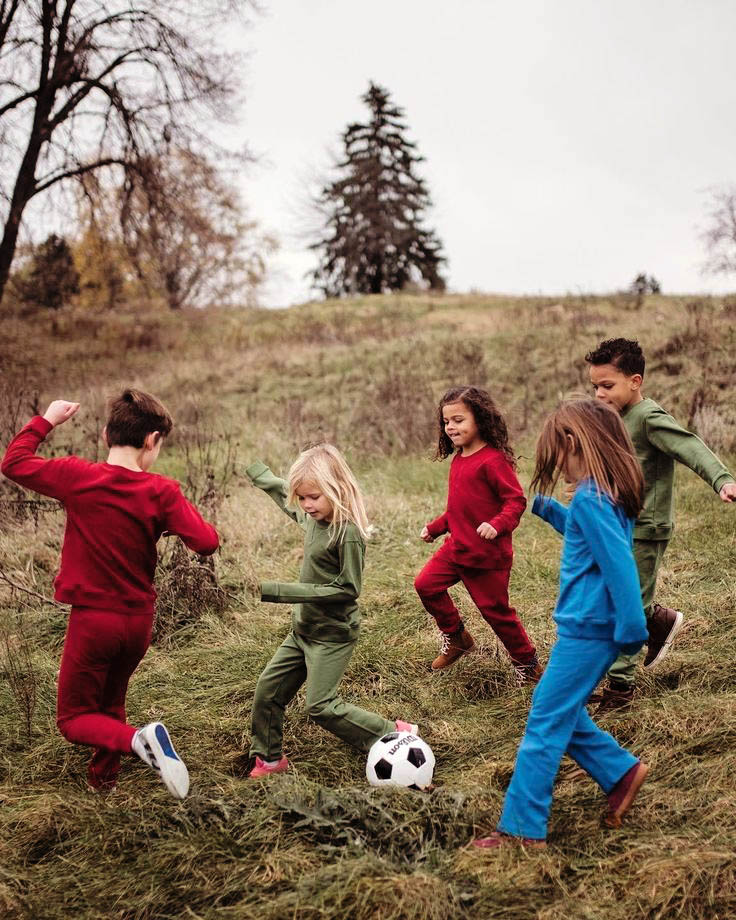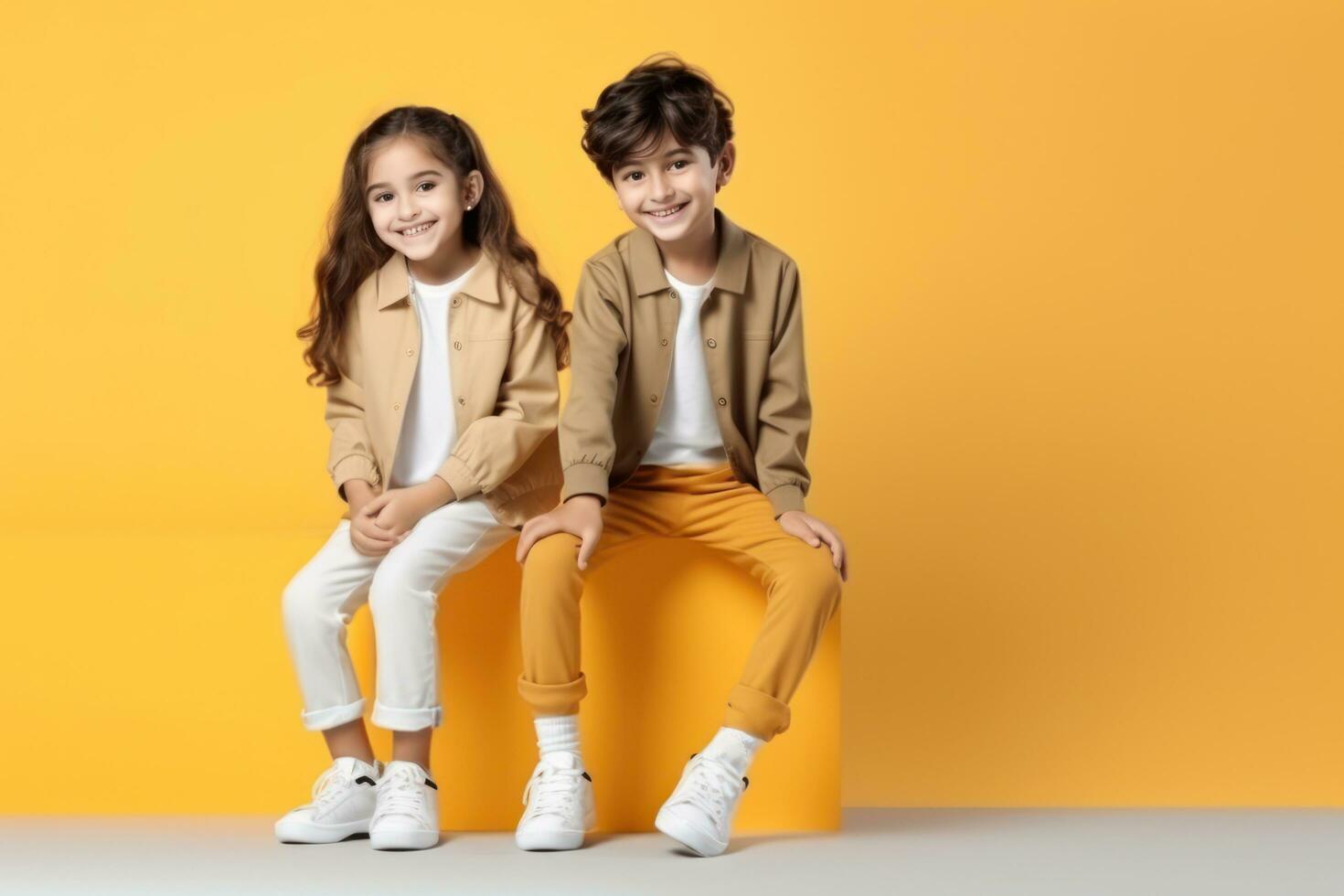Sustainable fashion for kids is growing in popularity. Parents now seek eco-friendly choices for their children’s wardrobes.
Understanding the impact of fashion on the environment is crucial. Sustainable trends focus on reducing waste, using organic materials, and ensuring fair labor practices. These trends not only protect the planet but also offer safe and stylish options for children.
Parents are increasingly aware of the benefits of sustainable fashion. They want to make informed choices that support ethical brands and practices. This blog will explore the latest sustainable fashion trends for kids, offering insights into how you can dress your little ones in eco-friendly attire. Let’s dive into the world of sustainable fashion and discover how it benefits both our kids and the planet.
Introduction To Sustainable Fashion
Sustainable fashion trends for kids focus on eco-friendly materials and ethical production. Parents seek stylish, durable clothing that is kind to the planet. Brands offer adorable, eco-conscious options for children.
Sustainable fashion is a growing trend in the clothing industry. It’s about creating clothes that are kind to the environment. This means using materials that do not harm our planet. It also involves treating workers fairly. Sustainable fashion is not just for adults. Kids can wear eco-friendly clothes too. Parents are becoming more aware of the impact of their choices. They want to buy clothes that are good for their children and the Earth.Why It Matters
Sustainable fashion helps reduce waste. Many clothes end up in landfills. This is bad for the environment. Eco-friendly clothes last longer. They can be passed down to other children. This reduces the need to buy new clothes often. It also saves water. Making clothes uses a lot of water. Sustainable fashion brands use less water. They also avoid harmful chemicals. This keeps our water clean.Impact On Kids’ Fashion
Kids’ fashion is changing. More brands are offering sustainable options. These clothes are stylish and comfortable. They come in many colors and designs. Children can look good and feel good. Parents are teaching their kids about sustainability. They explain why it is important to care for the planet. Kids learn to make better choices. They understand the value of quality over quantity. Sustainable fashion is also about ethics. Children learn about fair labor practices. They know their clothes were made by workers who are paid fairly. This helps them develop a sense of justice. In conclusion, sustainable fashion is important for the future. It makes a big difference in kids’ fashion. Families are making choices that help protect our planet. “`Eco-friendly Materials
Parents seek sustainable fashion for kids. Eco-friendly materials are a key trend. These materials are safe and gentle on children’s skin. They also help the environment. Two popular choices are organic cotton and recycled fabrics.
Organic Cotton
Organic cotton is grown without harmful pesticides. This makes it a safe choice for kids. It is soft, breathable, and hypoallergenic. Parents prefer it for its comfort and safety.
Organic cotton farming also uses less water. This helps conserve natural resources. It supports healthier soil and reduces pollution. Choosing organic cotton means supporting sustainable farming practices.
Recycled Fabrics
Recycled fabrics come from repurposed materials. These can include plastic bottles, old garments, and fabric scraps. This process reduces waste and conserves resources. It helps keep materials out of landfills.
Recycled fabrics are durable and versatile. They can be used for various types of kids’ clothing. This includes t-shirts, jackets, and even shoes. Using recycled fabrics helps reduce the environmental footprint.
Here is a simple comparison table:
| Material | Benefits |
|---|---|
| Organic Cotton | Soft, hypoallergenic, less water usage, no harmful pesticides |
| Recycled Fabrics | Reduces waste, durable, versatile, conserves resources |
Choosing eco-friendly materials like organic cotton and recycled fabrics is a great way to embrace sustainable fashion for kids. It ensures comfort, safety, and a better future for our planet.
Fair Trade Clothing
Fair trade clothing ensures that workers receive a fair wage. Fair trade practices empower workers and uphold their rights. This is important in the fashion industry, especially for kids. Parents want to ensure their children wear clothes made ethically. Fair trade clothing for kids combines style with responsibility.
Ethical Manufacturing
Ethical manufacturing focuses on safe working conditions and fair pay. Factories follow strict guidelines to ensure a healthy environment. Workers are treated with respect and given fair wages.
Ethical manufacturing also reduces the impact on the environment. Factories use sustainable materials and processes. This means less waste and pollution. Parents can feel good about purchasing clothes made ethically.
Here are some key points of ethical manufacturing:
- Safe working conditions
- Fair wages
- Respect for workers
- Use of sustainable materials
- Reduced environmental impact
Support For Artisans
Fair trade clothing often supports local artisans. These artisans create unique, handcrafted items. By purchasing fair trade, you support their skills and traditions. This helps preserve cultural heritage and provides a stable income for artisans.
Supporting artisans has several benefits:
- Encourages traditional craftsmanship
- Provides fair income to artisans
- Preserves cultural heritage
- Promotes unique and high-quality products
Parents can find beautiful, one-of-a-kind clothing for their kids. This ensures that children stand out while wearing ethically made clothes.
Hand-me-down Culture
Hand-me-down culture is gaining popularity in sustainable fashion for kids. Parents are becoming more aware of the environmental impact of fast fashion. Reusing and recycling clothes can significantly reduce waste. This practice also teaches children the value of sustainability from a young age.
Benefits Of Second-hand
Second-hand clothes offer many benefits. They are often more affordable than new clothes. This allows families to save money while still dressing their kids in stylish outfits. Second-hand clothing also tends to be unique, so kids can have a distinct look. Another key benefit is the reduction of textile waste. Reusing clothes means fewer items end up in landfills. This helps protect our planet for future generations.
Creating A Circular Wardrobe
Creating a circular wardrobe involves reusing, recycling, and sharing clothes. Start by organizing your child’s wardrobe. Sort out clothes that no longer fit but are still in good condition. These items can be passed down to younger siblings or friends. You can also donate them to local charities or thrift stores. Another option is to participate in clothing swaps. These events allow parents to exchange clothes, ensuring nothing goes to waste. By embracing the hand-me-down culture, you contribute to a sustainable future.
Diy Kids’ Fashion
Sustainable fashion for kids can be fun and creative. DIY kids’ fashion is an excellent way to teach children about sustainability. It involves upcycling old clothes and simple sewing projects. This section explores exciting and easy DIY fashion ideas for kids.
Upcycling Old Clothes
Upcycling old clothes can be a fun family activity. Turn adult-sized T-shirts into dresses or tunics for kids. Old jeans can transform into stylish shorts or skirts. Children can add patches, embroidery, or fabric paint to personalize their clothes. This not only saves money but also reduces waste.
Simple Sewing Projects
Simple sewing projects can be a great way for kids to learn new skills. Start with easy items like headbands, tote bags, or pillowcases. You can use fabric scraps from other projects. Teach kids basic stitches and let them create their designs. This encourages creativity and boosts their confidence. Plus, it results in unique and sustainable fashion pieces.

Credit: torlykid.com
Brands Leading The Way
Sustainable fashion for kids is growing. Parents are more aware of eco-friendly choices. Many brands are leading the way in this movement. They offer stylish, sustainable options for children. Let’s explore some popular and emerging brands.
Popular Eco-friendly Brands
Several well-known brands focus on sustainability. These brands use organic materials and ethical practices.
Patagonia: Known for its commitment to the environment. Patagonia offers durable, organic cotton clothes for kids.
H&M Conscious: H&M’s Conscious line includes kids’ clothes made from recycled materials. It’s stylish and affordable.
Mini Rodini: This Swedish brand uses organic and recycled materials. Mini Rodini ensures fair labor practices in their factories.
Emerging Sustainable Labels
New labels are entering the sustainable fashion scene. These brands bring fresh, eco-friendly designs for children.
Little Green Radicals: They create playful, organic cotton clothes. Little Green Radicals ensures fair wages for workers.
Frugi: Frugi offers bright, organic cotton clothes. They also use recycled plastic bottles for their outerwear.
MORI: MORI focuses on soft, organic fabrics. Their clothes are gentle on a baby’s skin and the planet.
Capsule Wardrobes For Kids
Creating a capsule wardrobe for kids is a smart and sustainable choice. It simplifies dressing up, reduces waste, and saves money. The key is to choose versatile and durable pieces. This approach helps in building a functional and stylish wardrobe for your little ones.
Minimalist Approach
A minimalist approach focuses on quality over quantity. Select a few essential clothing items that mix and match well. This reduces the number of clothes needed. It also makes dressing up quicker and easier. Kids can still have fun with their outfits without feeling overwhelmed by too many choices.
Versatile Clothing Pieces
Choose versatile clothing pieces that can be worn in different ways. T-shirts, leggings, and jackets are great examples. Neutral colors work best because they can be paired with anything. Patterns and prints add fun without needing extra pieces. Such clothes are useful across different seasons and occasions.
Look for adjustable sizes or stretchy fabrics. Kids grow fast, so adaptable clothes last longer. This saves money and reduces waste. It also ensures your kids always have clothes that fit well.

Credit: milimilu.com
Seasonal Sustainable Trends
Seasonal sustainable trends in kids’ fashion are gaining popularity. Parents want eco-friendly clothes for their children. These trends focus on using organic materials and ethical production methods. They also emphasize durability and comfort, ensuring kids look stylish while being kind to the environment. Let’s explore the latest sustainable fashion trends for kids, focusing on spring/summer and fall/winter collections.
Spring/summer Styles
Spring and summer bring bright colors and lightweight fabrics. Sustainable brands offer a variety of options for these seasons.
- Organic Cotton Dresses: Perfect for warm weather, these dresses are soft and breathable.
- Linen Shorts: These shorts keep kids cool and comfortable.
- Recycled Swimwear: Made from plastic bottles, these swimsuits are eco-friendly and stylish.
Look for brands that use natural dyes and avoid harmful chemicals. This ensures the clothes are safe for kids and the planet.
Fall/winter Collections
Fall and winter collections focus on warmth and durability. Sustainable fashion offers cozy and eco-friendly options.
- Wool Sweaters: Made from organic wool, these sweaters are warm and soft.
- Recycled Polyester Jackets: These jackets provide warmth without harming the environment.
- Organic Cotton Leggings: Perfect for layering, these leggings are comfortable and durable.
Choose brands that prioritize ethical production practices. This ensures workers are treated fairly and the environment is protected.
Embrace these seasonal sustainable trends to keep your kids stylish and eco-friendly year-round.
Eco-friendly Accessories
Eco-friendly accessories for kids are gaining popularity. Parents want sustainable options. These accessories are both stylish and kind to the planet. They reduce waste and often use recycled materials. Let’s explore some top eco-friendly accessories for kids.
Sustainable Footwear
Kids love to run and play. Sustainable footwear supports their active lifestyle while caring for the Earth. Shoes made from organic cotton, recycled rubber, and other eco-friendly materials fit the bill. Brands now offer many styles without harmful chemicals. These shoes last longer and can be passed down to siblings. This reduces waste and saves money.
Green Backpacks And Bags
Backpacks and bags are essential for kids. They carry school supplies, snacks, and toys. Green options are available now. These bags use recycled materials and natural fibers. They are durable and stylish. Some brands even offer bags that grow with your child. Adjustable straps and compartments make them versatile. Investing in a green backpack helps reduce your carbon footprint.
Educational Resources
Exploring sustainable fashion trends for kids involves teaching them about eco-friendly choices. Educational resources play a crucial role in this learning journey. They help children understand the impact of their clothing choices. Kids can learn through books, workshops, and interactive activities. Let’s dive into some engaging educational resources.
Books On Sustainable Fashion
Books are a great way to introduce kids to sustainable fashion. They can read stories about eco-friendly practices. These books often feature colorful illustrations and simple language. This makes the learning process fun and easy.
Some books focus on the journey of clothes, from production to disposal. Others highlight the importance of recycling and reusing. These stories can inspire kids to make better choices. They can learn to appreciate the value of sustainable fashion.
Interactive Workshops
Interactive workshops offer hands-on learning experiences. Kids can engage in activities that teach sustainable practices. They might learn how to upcycle old clothes. Or they could participate in DIY projects that promote recycling.
Workshops can also include games and group activities. These activities make learning about sustainability enjoyable. Children can see the impact of their actions firsthand. This can motivate them to adopt eco-friendly habits.
Overall, educational resources can make sustainable fashion exciting for kids. Through books and workshops, they can learn to make better choices. Let’s empower the next generation to embrace sustainability.
Community Initiatives
Sustainable fashion for kids is not just a trend. It’s a movement driven by community initiatives. These efforts not only promote eco-friendly practices but also foster a sense of responsibility in young minds. Two significant initiatives making waves are local clothing swaps and school programs.
Local Clothing Swaps
Local clothing swaps are gaining popularity. Parents bring gently used clothes their kids have outgrown. They exchange them for other items. This reduces waste and saves money. Kids get new outfits without buying new clothes. It’s also a fun community event. Parents and kids meet others who care about the environment.
School Programs
Schools are joining the sustainable fashion movement. Many have started programs to educate kids about eco-friendly choices. They teach kids to care for their clothes. They also encourage upcycling projects. Kids learn to create new items from old clothes. These activities make learning fun and practical. They also build a sense of achievement in kids.
Challenges And Solutions
Sustainable fashion for kids faces unique challenges. But there are smart solutions. Parents often worry about costs, durability, and practicality. Let’s explore how to overcome these barriers.
Overcoming Cost Barriers
Sustainable clothing can be expensive. This is a major concern for parents. But there are ways to make it affordable. Here are some ideas:
- Thrift Shopping: Second-hand stores offer great deals on quality clothes.
- Clothing Swaps: Organize swaps with other parents to exchange gently used items.
- Seasonal Sales: Look for discounts during off-season sales.
These options help keep costs low while ensuring sustainability.
Encouraging Long-term Use
Kids outgrow clothes quickly. This poses a challenge for sustainable fashion. Here are some solutions:
- Adjustable Clothing: Buy clothes with adjustable features like elastic waists.
- Unisex Designs: Choose neutral designs that can be passed down to siblings.
- High-Quality Materials: Invest in durable fabrics that last longer.
These strategies ensure clothes last longer and reduce waste.
Future Of Kids’ Sustainable Fashion
The future of kids’ sustainable fashion looks promising. Parents are more conscious of the environment. They seek eco-friendly options for their children. This shift has led to exciting trends in kids’ fashion. Let’s explore these trends and their impact on the industry.
Innovative Materials
One key trend is the use of innovative materials. Brands are using organic cotton and recycled fabrics. These materials are gentle on the skin and the planet. Bamboo and hemp fabrics are becoming popular too. They are durable and biodegradable. This means less waste in landfills.
Another exciting material is Tencel. It is made from wood pulp. Tencel is soft, breathable, and eco-friendly. Sustainable fashion brands are also exploring plant-based dyes. They reduce the use of harmful chemicals. This ensures safer clothing for kids.
Growing Awareness
Awareness about sustainable fashion is growing. Schools and communities are educating parents and children. They teach the benefits of eco-friendly clothing. This knowledge drives demand for sustainable options.
Social media also plays a role. Influencers share tips on buying sustainable kids’ clothes. They highlight brands that focus on ethical production. This spreads awareness to a broader audience.
Parents are also looking for clothing that lasts longer. They prefer quality over quantity. This shift supports the slow fashion movement. It encourages buying fewer but better-quality items.

Credit: www.kidsfashioncare.com
Frequently Asked Questions
What Are The Latest Sustainable Fashion Trends For Kids?
Sustainable fashion for kids includes organic fabrics, recycled materials, and eco-friendly dyes. Clothes are durable and stylish.
Why Choose Organic Fabrics For Kids’ Clothing?
Organic fabrics are free from harmful chemicals. They are safer for kids and better for the environment.
How To Identify Eco-friendly Kids’ Brands?
Look for certifications like GOTS or OEKO-TEX. These labels ensure the brand follows eco-friendly practices.
Are Recycled Materials Used In Kids’ Fashion?
Yes, many brands use recycled materials. This reduces waste and conserves resources, making it a sustainable choice.
What Benefits Do Sustainable Clothes Offer For Kids?
Sustainable clothes are soft, skin-friendly, and long-lasting. They also help protect the planet for future generations.
Conclusion
Sustainable fashion for kids makes a big difference. It’s eco-friendly and stylish. Parents can teach kids about caring for the planet. Choose clothes made from organic materials. Support brands that follow ethical practices. Reuse and recycle old clothes creatively. These small steps help create a better world.
Start making conscious choices today. Sustainable fashion is not just a trend. It’s a lifestyle worth adopting. Your kids will love it. Let’s make the future bright and green together.







